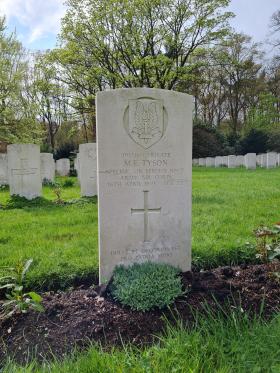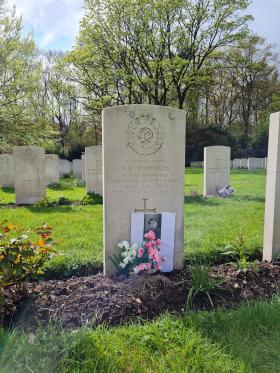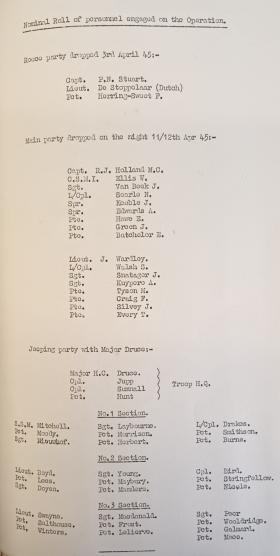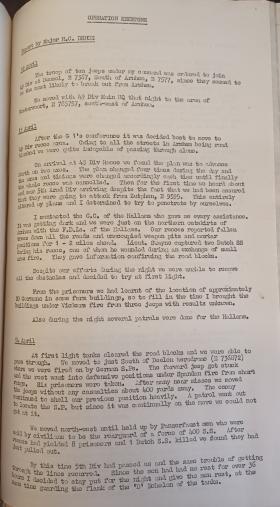Operation ‘Keystone’ was a British special forces operation by a Jeep-mounted Squadron of the 2nd Special Air Service under the command of Major Henry Druce with the objectives of interfering with German movements to the south of the IJsselmeer (Zuiderzee) in the German-occupied Netherlands and capturing bridges over the Apeldoorn Canal to aid Operation ‘Cannonshot’ (3 April/late April 1945).
On 3 April an advance party, under the command of Captain Richard Holland, was landed to secure a dropping zone and link with the local resistance forces. This was achieved, though the party’s radio was smashed on landing. A second party, unable to identify the pre-arranged reception signals, returned to the UK. The main party and its Jeeps were parachuted into the operational area on 11 April, but two later attempts to drop men and vehicles were unsuccessful as a result of bad weather. A second Jeep party under Druce was therefore tasked with driving to the north and linking up with the forward group. Though it had difficulty getting through the German lines, Druce’s team eventually joined the second group on 18 April. The united squadron then drove to the north-east to join the ‘Archway’ teams. Although ‘Keystone’ did succeed in inflicting damage and casualties on the Germans, the operation suffered because the SAS was wrongly used for tactical reconnaissance just ahead of the advancing main armies and not for a deep-penetration reconnaissance.
OPERATION KEYSTONE. APRIL 1945.
Report by Capt. R.J. HOLLAND, M.C.
11/12th April 1945.
The DZ at Z 518038 was marked with white lights but as the pilot had been briefed to look for a system of coloured lights, which was the method adopted by S.F., there was a slight hesitation while the pilot asked me whether I wished to jump. We dropped at 00.15 hrs, a little wide of the DZ. Four kitbag ropes broke on the way down, including my own (I suggest stouter ropes be used in future). Otherwise the drop was successful and the reception was good. We were taken to a barn at Z 519040 where we laid up for the night.
12th April 1945.
I saw Pete von Arnhem's Chief of Staff and discussed local intelligence. I ascertained the area was suitable for jeeping and sent a message for Capt. Smith to follow. I heard there might be a drop that night. I then made arrangements to receive Capt. Smith and jeeps and acquired a horse to assist in the event of the jeeps getting ditched. The drop was not confirmed and the reception party dispersed.
At night I sent out three parties:-
(1) Lieut. Stuart with four men to recce the Putten-Voorthuison rd.
(2) Lieut. Wardley with his stick to the Putten - Nijkerk road, where he dealt with a motor vehicle at Z 4907.
(3) S.M. Ellis with his stick to Z 575030 on the Voorthuizen - Apeldoorn road.
13 April 1945.
I spent the day receiving news and information from the local Resistance party. At night I took a party to the Putten - Voorthuizen road. Tyre bursters were laid but a staff car which hit one proceeded on its way, firing blind. We fired back.
S.M. Ellis and his party brewed up the last truck of a convoy of five vehicles proceeding in a westerly direction on the Apeldoorn - Amersfoort road (area Z 5802). The final result was not observed as there were many Germans in the area.
Sgt. Van Beek took a party and laid a charge on the railway line at Z 4907. On their way back they captured a German but after threatening and interrogating him they sent him off.
Lieut. Wardley took his party to Z 5008 and had some shooting. On the way back they placed a charge on the railway line.
Lieut. Stuart did not achieve anything with the party he took out.
14 April 1945.
Nothing of interest occurred during the day. At night I took a party to the Putten - Voorthuizen road and placed tyrebursters on the road at Z 546042. Several cars passed over them but nothing happened. One tyreburster was dud; well encased in plastic it was squashed flat by a huge supply vehicle and trailer.
S.M. Ellis's party, which had accompanied us to the road, went to operate in the area Z 5806 but ran into a group of suspicious characters at Z 540036 and after a short sharp exchange of fire retired. We learnt later it was a Resistance party which should not have been in the area.
Lieut. Wardley, Sgt. Kuypers and Cpl. Walsh, went North to the Nijkerk - Amersfoort railway. They ran into trouble and were chased all the next day.
15 April 1945.
As I had not achieved anything during the night I took a party in daylight to Z 546042. On the way I found Pte. Keeble unconscious at Z 5436 where S.M. Ellis had had an exchange of fire with a Resistance party. I told a Dutch civilian to report it and heard later that he was taken by the Germans and died on the way to hospital.
While I was away, Lieut. Stuart caused me some annoyance by sending a coded message about the food situation. However, I was able to add to the message before it was despatched. I waited until Lieut. Wardley's party arrived and then moved camp to another barn at Z 505054.
By this time Pete von Arnhem had organised at my request three groups of Resistance parties in the south-east. One was operating in the Ede - Apeldoorn road, another on the subsidiary roads to Arnhem, and the third on the Apeldoorn - Arnhem road. I received no details of the damage they inflicted or the composition of the parties, but I was satisfied they were carrying out their tasks.
That night I took Pte. Hawe and Pte. Silvey with one guide to the Putten - Nijkerk road area. The main traffic was along this road while the Zwolle - Nijkerk - Amersfoort line was also being used. While we were preparing to lay our charges on the road at Z 526086 we were challenged by two sentries at about three yards range. I fired immediately at the spot I thought them to be. They did not reply but
it was too dark to see what happened to them.
S.M. Ellis, Sgt. Van Beek, Cpl. Searle and Pte. Edwards, attacked the Putten - Nijkerk railway line. They laid charges and time pencils at Z 509079 and both tracks were cut. This line was being used quite a lot by the Germans and was evidently important as Lieut. Wardley later saw them repairing it.
Lieut. Wardley, Lieut. Stuart and Pte. Tyson opened fire on a goods train on this line at Z 486067 previous to S.M. Ellis’s attack.
16 April 1945.
I led the whole party in daylight to a fork road at Z 483034 as Germans were reputed to be in that vicinity. We surprised and captured 8 Germans who were sitting alongside trucks in a farmyard having lunch, and about 30 others in a neighbouring farm were put to flight. I kept one of the prisoners to help us start the trucks while the other seven were marched back to our base. Unfortunately Pte. Hawe and the escort which was taking the prisoners back to base encountered a German patrol and to avoid being captured had to leave the prisoners. Nevertheless we had achieved our object of causing a disturbance to the enemy and we retired with our one prisoner to the barn at Z 505054.
That night myself, Sgt. Van Beek, Pte. Edwards and Pte. Hawe went to lay an ambush on the Putten - Nijkerk road. We ran into a number of German cyclists at Z 520085 who had apparently lost their way
(I had switched the German signposts at this spot when returning from our operation the night before). The road was attacked with carbines and Stens and the enemy reacted strongly, continuing to fire long after the party was back in camp.
The Canadians at this time were reported to be at Barneveld, Z 528958.
17 April 1945.
I sent S.M. Ellis, Sgt. Van Beek and Cpl. Searle to the Putten - Voorthuizen road and at pt Z 523057 they stopped two German cyclists. They were medical officers hurrying to attend wounded at Nijkerk, Z 4605. After grilling they were allowed to proceed. The SAS party were spotted on their way back by a German patrol of ten men and had to shoot their way through.
Lieut. Wardley, Lieut. Stuart and 2 O.Rs. were sent to recce the area of Z 4804. After they had returned Pte. Tyson was accidentally killed by one of our party while weapons were being cleaned.
The Resistance party brought in four prisoners. Cpl. Searle had brought in 2 earlier in the day so that together with a driver we had captured the day before, we now held 7.
At 14.00 hrs I sent a signal to the U.K. giving our position and asking for help from the Canadians to block the Putten – Nijkerk road. A reply was received to the effect that my message had been
forwarded to the Canadians.
I did not intend operating that night until midnight, but at 23.00 hrs we were shelled. Pte. Edwards who was on sentry duty was killed by the first shell. Our position was good and had adequate cover nearby so I decided to remain as I thought it was to be only temporary harassing fire. However, the shelling continued to be consistently near and Lieut. Wardley evacuated his stick into the woods.
The map indicates the barn on the wrong side of the road and the majority of the shells fell 20 yards East where the barn was marked on the map.
18 April 1945.
A Resistance man had been injured during the night by the shelling so I went to Voorthuizen, Z 545010, where I hoped to contact the Canadians and obtain medical help for the wounded man. On my return I found Major Druce had arrived with his party. We discussed an operation for that night but decided my men were tired after the shelling the previous night and the week’s operations.
Major Druce took a party of Resistance men with his own party to the Nijkerk - Ermele road but had no success.
19 April 1945.
I contacted the Canadians at Barneveld, then Major Druce and I took our parties to Nijmegen, E 7060, and met Major Hibbert with his party.
After two nights I brought Cpl. Searle and Pte. Hawe by a three-ton lorry to Brussels where we eventually flew to Croydon aerodrome on the 24th April.
Source:
Created with information kindly supplied by R Hilton
Read More








Latest Comments
There are currently no comments for this content.
Add Comment
In order to add comments you must be registered with ParaData.
If you are currently a ParaData member please login.
If you are not currently a ParaData member but wish to get involved please register.